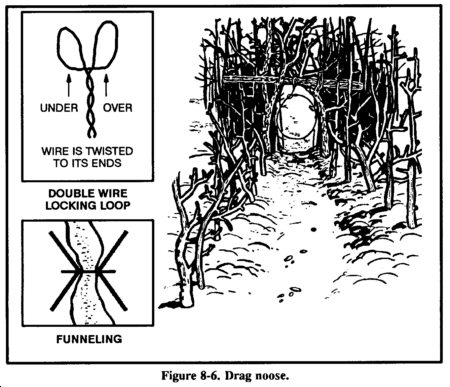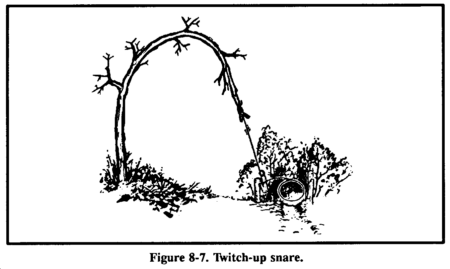Drag Noose
Use a drag noose on an animal run (Figure 8-6).
Place forked sticks on either side of the run and lay a sturdy cross member across them.
Tie the noose to the cross member and hang it at a height above the animal's head. (Nooses
designed to catch by the head should never be low enough for the prey to step into with a foot.)
As the noose tightens around the animal's neck, the animal pulls the cross member from the
forked sticks and drags it along. The surrounding vegetation quickly catches the cross member and
the animal becomes entangled.

Twitch-Up
A twitch-up is a supple sapling, which, when bent over and secured with a
triggering device, will provide power to a variety of snares. Select a hardwood
sapling along the trail. A twitch-up will work much faster and with more force
if you remove all the branches and foliage.
Twitch-Up Snare
A simple twitch-up snare uses two forked sticks, each with a long and short
leg (Figure 8-7). Bend the twitch-up and mark the trail
below it. Drive the long leg of one forked stick firmly into the ground at that point.
Ensure the cut on the short leg of this stick is parallel to the ground. Tie the long
leg of the remaining forked stick to a piece of cordage secured to the twitch-up.
Cut the short leg so that it catches on the short leg of the other forked stick. Extend
a noose over the trail. Set the trap by bending the twitch-up and engaging the short
legs of the forked sticks. When an animal catches its head in the noose, it pulls the
forked sticks apart, allowing the twitch-up to spring up and hang the prey.
Note: Do not use green sticks for the trigger.
The sap that oozes out could glue them together.

| Updated:
12 January 2008 |
|
Born on 28 October 1999 |



